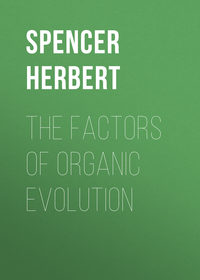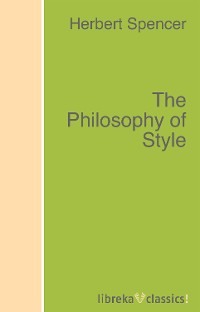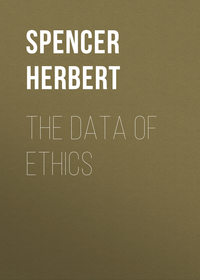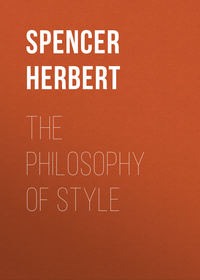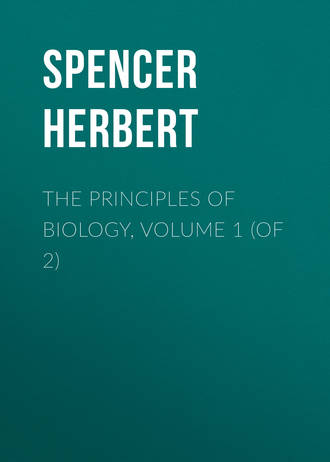 полная версия
полная версияThe Principles of Biology, Volume 1 (of 2)
Certain types, which are transitional between Protozoa and Metazoa, exhibit under its simplest form the relation between self-maintenance and race-maintenance – the integration primarily effecting the one and the disintegration primarily effecting the other. Among the Mycetozoa a number of amœba-like individuals aggregate into what is called a plasmodium; and while, in some orders, they become fused into a mass of protoplasm through which their nuclei are dispersed, in other orders (Sorophora) they retain their individualities and simply form a coherent aggregate. These last, presumably the earliest in order of evolution, remain united so long as the plasmodium, having a small power of locomotion, furthers the general nutrition; but when this is impeded by drought or cold, there arise spores. Each spore contains an amœboid individual; and this, escaping when favourable conditions return, establishes by fission and by union with others like itself a new colony or plasmodium. Reduced to its lowest terms, we here see the antagonism between that growth of the coherent mass of units which accompanies its physical prosperity, and that incoherence and dispersion of the units which follows unfavourable conditions and arrest of growth, and which presently initiates new plasmodia.
This antagonism, seen in these incipient Metazoa which show us none of that organization characterizing the Metazoa in general, is everywhere in more or less disguised forms exhibited by them – must necessarily be so if growth of the individual is a process of integration while formation of new individuals is a process of disintegration. And, primarily, it is an implication that whatever furthers the one impedes the other.
But now while recognizing the truth that nutrition and innutrition (using these words to cover not supply of nutriment only but the presence of other influences favourable or unfavourable to the vital processes) primarily determine the alternations of these; we have also to recognize the truth that from the beginning survival of the fittest has been shaping the forms and effects of their antagonism. By inheritance a physiological habit which modifies the form of the antagonism in a way favourable to the species, will become established. Especially will this be the case where the lives of the individuals have become relatively definite and where special organs have been evolved for casting off reproductive centres. The resulting physiological rhythm may in such cases become so pronounced as greatly to obscure the primitive relation. Among plants we see this in the fact that those which have been transferred from one habitat to another having widely different seasons, long continue their original time of flowering, though it is inappropriate to the new circumstances – the reproductive periodicity has become organic. Similarly in each species of higher animal, development of the reproductive organs and maturation of reproductive cells take place at a settled age, whether the conditions have been favourable or unfavourable to physical prosperity. The established constitutional tendency, adapted to the needs of the species, over-rides the constitutional needs of the individual.
Even here, however, the primitive antagonism, though greatly obscured, occasionally shows itself. Instance the fact that in plants where gamogenesis is commencing a sudden access of nutrition will cause resumption of agamogenesis; and I suspect that an illustration may be found among human beings in the earlier establishment of the reproductive function among the ill-fed poor than among the well-fed rich.
One other qualification has to be added. In plants and animals which have become so definitely constituted that at an approximately fixed stage, the proclivity towards the production of new individuals becomes pronounced, it naturally happens that good nutrition aids it. Surplus nutriment being turned into the reproductive channel, the reproduction is efficient in proportion as the surplus is great. Hence the fact that in fruit trees which have reached the flowering stage, manuring has the effect that though it does not increase the quantity of blossoms it increases the quantity of fruit; and hence the fact that well-fed and easy-living races of men are prolific.
CHAPTER VIII.
HEREDITY
§ 80. Already, in the last two chapters, the law of hereditary transmission has been tacitly assumed; as, indeed, it unavoidably is in all such discussions. Understood in its entirety, the law is that each plant or animal, if it reproduces, gives origin to others like itself: the likeness consisting, not so much in the repetition of individual traits as in the assumption of the same general structure. This truth has been rendered so familiar by daily illustration as almost to have lost its significance. That wheat produces wheat – that existing oxen have descended from ancestral oxen – that every unfolding organism eventually takes the form of the class, order, genus, and species from which it sprang; is a fact which, by force of repetition, has acquired in our minds almost the aspect of a necessity. It is in this, however, that Heredity is principally displayed: the manifestations of it commonly referred to being quite subordinate. And, as thus understood, Heredity is universal. The various instances of heterogenesis lately contemplated seem, indeed, to be at variance with this assertion. But they are not really so. Though the recurrence of like forms is, in these instances, not direct but cyclical, still, the like forms do recur; and, when taken together, the group of forms produced during one of the cycles is as much like the groups produced in preceding cycles, as the single individual arising by homogenesis is like ancestral individuals.
While, however, the general truth that organisms of a given type uniformly descend from organisms of the same type, is so well established by infinite illustrations as to have assumed the character of an axiom; it is not universally admitted that non-typical peculiarities are inherited. Many entertain a vague belief that the law of Heredity applies only to main characters of structure and not to details; or, at any rate, that though it applies to such details as constitute differences of species, it does not apply to smaller details. The circumstance that the tendency to repetition is in a slight degree qualified by the tendency to variation (which, as we shall hereafter see, is but an indirect result of the tendency to repetition), leads some to doubt whether Heredity is unlimited. A careful weighing of the evidence, however, and a due allowance for the influences by which the minuter manifestations of Heredity are obscured, may remove this scepticism.
First in order of importance comes the fact that not only are there uniformly transmitted from an organism to its offspring, those traits of structure which distinguish the class, order, genus, and species; but also those which distinguish the variety. We have numerous cases, among both plants and animals, where, by natural or artificial conditions, there have been produced divergent modifications of the same species; and abundant proof exists that the members of any one sub-species habitually transmit their distinctive peculiarities to their descendants. Agriculturists and gardeners can furnish unquestionable illustrations. Several varieties of wheat are known, of which each reproduces itself. Since the potato was introduced into England there have been formed from it a number of sub-species; some of them differing greatly in their forms, sizes, qualities, and periods of ripening. Of peas, also, the like may be said. And the case of the cabbage-tribe is often cited as showing the permanent establishment of races which have diverged widely from a common stock. Among fruits and flowers the multiplication of kinds, and the continuance of each kind with certainty by agamogenesis, and to some extent by gamogenesis, might be exemplified without end. From all sides evidence may be gathered showing a like persistence of varieties among animals. We have our distinct breeds of sheep, our distinct breeds of cattle, our distinct breeds of horses: each breed maintaining its characteristics. The many sorts of dogs which, if we accept the physiological test, we must consider as all of one species, show us in a marked manner the hereditary transmission of small differences – each sort, when kept pure, reproducing itself not only in size, form, colour, and quality of hair, but also in disposition and speciality of intelligence. Poultry, too, have their permanently-established races. And the Isle of Man sends us a tail-less kind of cat. Even in the absence of other evidence, that which ethnology furnishes would suffice. Grant them to be derived from one stock, and the varieties of man yield proof upon proof that non-specific traits of structure are bequeathed from generation to generation. Or grant only their derivation from several stocks, and we still have, between races descended from a common stock, distinctions which prove the inheritance of minor peculiarities. Besides seeing the Negroes continue to produce Negroes, copper-coloured men to produce men of a copper colour, and the fair-skinned races to perpetuate their fair skins – besides seeing that the broad-faced and flat-nosed Calmuck begets children with broad faces and flat noses, while the Jew bequeaths to his offspring the features which have so long characterized Jews; we see that those small unlikenesses which distinguish more nearly-allied varieties of men, are maintained from generation to generation. In Germany, the ordinary shape of skull is appreciably different from that common in Britain: near akin though the Germans are to the British. The average Italian face continues to be unlike the faces of northern nations. The French character is now, as it was centuries ago, contrasted in sundry respects with the characters of neighbouring peoples. Nay, even between races so closely allied as the Scotch Celts, the Welsh Celts, and the Irish Celts, appreciable differences of form and nature have become established.
The fact that sub-species and sub-sub-species thus exemplify the general law of inheritance which shows itself in the perpetuation of ordinal, generic, and species peculiarities, is strong reason for the belief that this general lay is unlimited in its application. This has the support of still more special evidences. They are divisible into two classes. In the one come cases where congenital peculiarities, not traceable to any obvious causes, are bequeathed to descendants. In the other come cases where the peculiarities thus bequeathed are not congenital, but have resulted from changes of functions during the lives of the individuals bequeathing them. We will consider first the cases that come in the first class.
§ 81. Note at the outset the character of the chief testimony. Excluding those inductions that have been so fully verified as to rank with exact science, there are no inductions so trustworthy as those which have undergone the mercantile test. When we have thousands of men whose profit or loss depends on the truth of their inferences from perpetually-repeated observations; and when we find that their inferences, handed down from generation to generation, have generated an unshakable conviction; we may accept it without hesitation. In breeders of animals we have such a class, led by such experiences, and entertaining such a conviction – the conviction that minor peculiarities of organization are inherited as well as major peculiarities. Hence the immense prices given for successful racers, bulls of superior forms, sheep that have certain desired peculiarities. Hence the careful record of pedigrees of high-bred horses and sporting dogs. Hence the care taken to avoid intermixture with inferior stocks. As quoted by Mr. Darwin, Youatt says the principle of selection "enables the agriculturist not only to modify the character of his flock but to change it altogether." Lord Somerville, speaking of what breeders have done for sheep, says: – "It would seem that they have chalked upon a wall a form perfect in itself and then given it existence." That most skilful breeder, Sir John Sebright, used to say, with respect to pigeons, that "he would produce any given feather in three years, but it would take him six years to obtain head and beak." In all which statements the tacit assertion is, that individual traits are bequeathed from generation to generation, and may be so perpetuated and increased as to become permanent distinctions.
Of special instances there are many besides that of the often-cited Otto-breed of sheep, descended from a single short-legged lamb, and that of the six-fingered Gratio Kelleia, who transmitted his peculiarity, in different degrees, to several of his children and to some of his grandchildren. In a paper contributed to the Edinburgh New Philosophical Journal for July, 1863, Dr. (now Sir John) Struthers gives cases of hereditary digital variations. Esther P – , who had six fingers on one hand, bequeathed this malformation along some lines of her descendants for two, three, and four generations. A – S – inherited an extra digit on each hand and each foot from his father; and C – G – , who also had six fingers and six toes, had an aunt and a grandmother similarly formed. A collection of evidence published by Mr. Sedgwick in the Medico-Chirurgical Review for April and for July, 1863, in two articles on "The Influence of Sex in limiting Hereditary Transmission," includes the following cases: – Augustin Duforet, a pastry-cook of Douai, who had but two instead of three phalanges to all his fingers and toes, inherited this malformation from his grandfather and father, and had it in common with an uncle and numerous cousins. An account has been given by Dr. Lepine, of a man with only three fingers on each hand and four toes on each foot, and whose grandfather and son exhibited the like anomaly. Béchet describes Victoire Barré as a woman who, like her father and sister, had but one developed finger on each hand and but two toes on each foot, and whose monstrosity re-appeared in two daughters. And there is a case where the absence of two distal phalanges on the hands was traced for two generations. The various recorded instances in which there has been transmission from one generation to another, of webbed-fingers, of webbed-toes, of hare-lip, of congenital luxation of the thigh, of absent patellæ, of club-foot, &c., would occupy more space than can here be spared. Defects in the organs of sense are also not unfrequently inherited. Four sisters, their mother, and grandmother, are described by Duval as similarly affected by cataract. Prosper Lucas details an example of amaurosis affecting the females of a family for three generations. Duval, Graffe, Dufon, and others testify to like cases coming under their observation.35 Deafness, too, is occasionally transmitted from parent to child. There are deaf-mutes whose imperfections have been derived from ancestors; and malformations of the external ears have also been perpetuated in offspring. Of transmitted peculiarities of the skin and its appendages, many cases have been noted. One is that of a family remarkable for enormous black eyebrows; another that of a family in which every member had a lock of hair of a lighter colour than the rest on the top of the head; and there are also instances of congenital baldness being hereditary. From one of our leading sculptors I learn that his wife has a flat mole under the foot near the little toe, and one of her sons has the same. Entire absence of teeth, absence of particular teeth, and anomalous arrangements of teeth, are recorded as traits that have descended to children. And we have evidence that soundness and unsoundness of teeth are transmissible.
The inheritance of tendencies to such diseases as gout, consumption, and insanity is universally admitted. Among the less-common diseases of which the descent has been observed, are ichthyosis, leprosy, pityriasis, sebaceous tumours, plica polonica, dipsomania, somnambulism, catalepsy, epilepsy, asthma, apoplexy, elephantiasis. General nervousness displayed by parents almost always re-appears in their children. Even a bias towards suicide appears to be sometimes hereditary.
§ 82. To prove the transmission of those structural peculiarities which have resulted from functional peculiarities, is, for several reasons, comparatively difficult. Changes produced in the sizes of parts by changes in their amounts of action, are mostly unobtrusive. A muscle which has increased in bulk is usually so obscured by natural or artificial clothing, that unless the alteration is extreme it passes without remark. Such nervous developments as are possible in the course of a single life, cannot be seen externally. Visceral modifications of a normal kind are observable but obscurely, or not at all. And if the changes of structure worked in individuals by changes in their habits are thus difficult to trace, still more difficult to trace must be the transmission of them: further hidden, as this is, by the influences of other individuals who are often otherwise modified by other habits. Moreover, such specialities of structure as are due to specialities of function, are usually entangled with specialities of structure which are, or may be, due to selection, natural or artificial. In most cases it is impossible to say that a structural peculiarity which seems to have arisen in offspring from a functional peculiarity in a parent, is wholly independent of some congenital peculiarity of structure in the parent, whence this functional peculiarity arose. We are restricted to cases with which natural or artificial selection can have had nothing to do, and such cases are difficult to find. Some, however, may be noted.
A species of plant that has been transferred from one soil or climate to another, frequently undergoes what botanists call "change of habit" – a change which, without affecting its specific characters, is yet conspicuous. In its new locality the species is distinguished by leaves that are much larger or much smaller, or differently shaped, or more fleshy; or instead of being as before comparatively smooth, it becomes hairy; or its stem becomes woody instead of being herbaceous; or its branches, no longer growing upwards, assume a drooping character. Now these "changes of habit" are clearly determined by functional changes. Occurring, as they do, in many individuals which have undergone the same transportation, they cannot be classed as "spontaneous variations." They are modifications of structure consequent on modifications of function that have been produced by modifications in the actions of external forces. And as these modifications re-appear in succeeding generations, we have, in them, examples of functionally-established variations that are hereditarily transmitted.
Evidence of analogous changes in animals is difficult to disentangle. Only among domesticated kinds have we any opportunity of tracing the results of altered habits; and here, in nearly all cases, artificial selection has obscured them. Still, there are some facts which seem to the point. Mr. Darwin, while ascribing almost wholly to "natural selection" the production of those modifications which eventuate in differences of species, nevertheless admits the effects of use and disuse. He says – "I find in the domestic duck that the bones of the wing weigh less and the bones of the leg more, in proportion to the whole skeleton, than do the same bones in the wild duck; and I presume that this change may be safely attributed to the domestic duck flying much less, and walking more, than its wild parent. The great and inherited development of the udders in cows and goats in countries where they are habitually milked, in comparison with the state of these organs in other countries, is another instance of the effect of use. Not a single domestic animal can be named which has not in some country drooping ears; and the view suggested by some authors, that the drooping is due to the disuse of the muscles of the ear, from the animals not being much alarmed by danger, seems probable." Again – "The eyes of moles and of some burrowing rodents are rudimentary in size, and in some cases are quite covered up by skin and fur. This state of the eyes is probably due to gradual reduction from disuse, but aided perhaps by natural selection." … "It is well known that several animals belonging to the most different classes, which inhabit the caves of Styria and of Kentucky, are blind. In some of the crabs the footstalk of the eye remains, though the eye is gone; the stand for the telescope is there, though the telescope with its glasses has been lost. As it is difficult to imagine that eyes, though useless, could be in any way injurious to animals living in darkness, I attribute their loss wholly to disuse."36 The direct inheritance of an acquired peculiarity is sometimes observable. Mr. Lewes gives a case. He "had a puppy taken from its mother at six weeks old, who, although never taught 'to beg' (an accomplishment his mother had been taught), spontaneously took to begging for everything he wanted when about seven or eight months old: he would beg for food, beg to be let out of the room, and one day was found opposite a rabbit hutch begging for rabbits." Instances are on record, too, of sporting dogs which spontaneously adopted in the field, certain modes of behaviour which their parents had learnt.
But the best examples of inherited modifications produced by modifications of function, occur in mankind. To no other cause can be ascribed the rapid metamorphoses undergone by the British races when placed in new conditions. In the United States the descendants of the immigrant Irish lose their Celtic aspect, and become Americanized. This cannot be ascribed to mixture, since the feeling with which Irish are regarded by Americans prevents any considerable amount of intermarriage. Equally marked is the case of the immigrant Germans who, though they keep very much apart, rapidly assume the prevailing type. To say that "spontaneous variation" increased by natural selection, can have produced this effect, is going too far. Peoples so numerous cannot have been supplanted in the course of two or three generations by varieties springing from them. Hence the implication is that physical and social conditions have wrought modifications of function and structure, which offspring have inherited and increased. Similarly with special cases. In the Cyclopædia of Practical Medicine, Vol. II., p. 419, Dr. Brown states that he "has in many instances observed in the case of individuals whose complexion and general appearance has been modified by residence in hot climates, that children born to them subsequently to such residence, have resembled them rather in their acquired than primary mien."
Some visible modifications of organs caused by changes in their functions, may be noted. That large hands are inherited by those whose ancestors led laborious lives, and that those descended from ancestors unused to manual labour commonly have small hands, are established opinions. It seems very unlikely that in the absence of any such connexion, the size of the hand should have come to be generally regarded as some index of extraction. That there exists a like relation between habitual use of the feet and largeness of the feet, we have strong evidence in the customs of the Chinese. The torturing practice of artificially arresting the growth of the feet, could never have become established among the ladies of China, had they not seen that a small foot was significant of superior rank – that is of a luxurious life – that is of a life without bodily labour. There is evidence, too, that modifications of the eyes, caused by particular uses of the eyes, are inherited. Short sight appears to be uncommon among peasants; but it is frequent among classes who use their eyes much for reading and writing, and is often congenital. Still more marked is this relation in Germany. There, the educated are notoriously studious, and judging from the numbers of young Germans who wear spectacles, there is reason to think that congenital myopia is very frequent among them.
Some of the best illustrations of functional heredity, are furnished by mental characteristics. Certain powers which mankind have gained in the course of civilization cannot, I think, be accounted for without admitting the inheritance of acquired modifications. The musical faculty is one of these. To say that "natural selection" has developed it by preserving the most musically endowed, seems an inadequate explanation. Even now that the development and prevalence of the faculty have made music an occupation by which the most musical can get sustenance and bring up families; it is very questionable whether, taking the musical career as a whole, it has any advantage over other careers in the struggle for existence and multiplication. Still more if we look back to those early stages through which the faculty must have passed before definite perception of melody was arrived at, we fail to see how those possessing the rudimentary faculty in a somewhat greater degree than the rest, would thereby be enabled the better to maintain themselves and their children. There is no explanation but that the habitual association of certain cadences of speech with certain emotions, has slowly established in the race an organized and inherited connection between such cadences and such emotions; that the combination of such cadences, more or less idealized, which constitutes melody, has all along had a meaning in the average mind, only because of the meaning which cadences had acquired in the average mind; and that by the continual hearing and practice of melody there has been gained and transmitted an increasing musical sensibility. Confirmation of this view may be drawn from individual cases. Grant that among a people endowed with musical faculty to a certain degree, spontaneous variation will occasionally produce men possessing it in a higher degree; it cannot be granted that spontaneous variation accounts for the frequent production, by such highly-endowed men, of men still more highly endowed. On the average, the children of marriages with others not similarly endowed, will be less distinguished rather than more distinguished. The most that can be expected is that this unusual amount of faculty shall re-appear in the next generation undiminished. How then shall we explain cases like those of Bach, Mozart, and Beethoven, all of them sons of men having unusual musical powers who were constantly exercising those powers, and who greatly excelled their fathers in their musical powers? What shall we say to the facts that Haydn was the son of an organist, that Hummel was born to a music master, and that Weber's father was a distinguished violinist? The occurrence of so many cases in one nation within a short period of time, cannot rationally be ascribed to the coincidence of "spontaneous variations." It can be ascribed to nothing but inherited developments of structure caused by augmentations of function.




